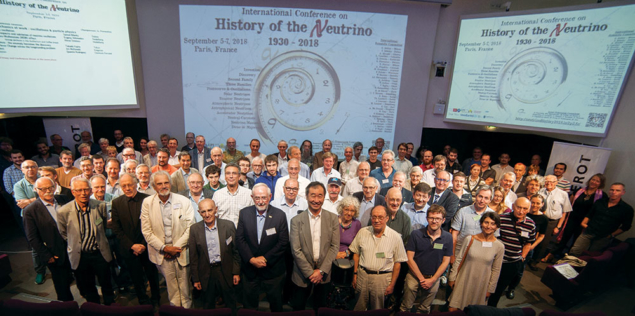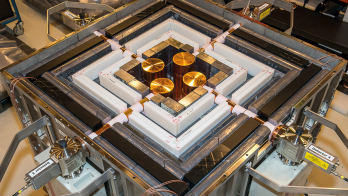
Neutrinos, discovered in 1956, play an exceptional role in particle and nuclear physics, as well as astrophysics, and their study has led to the award of several Nobel prizes. In recognition of their importance, the first International Conference on the History of the Neutrino took place at the Université Paris Diderot in Paris on 5–7 September 2018.
The purpose of the conference, which drew 120 participants, was to cover the main steps in the history of the neutrino since 1930, when Wolfgang Pauli postulated its existence to explain the continuous energy spectrum of the electrons emitted in beta decay. Specifically, for each topic in neutrino physics, the aim was to pursue an historical approach and follow as closely as possible the discovery or pioneering papers. Speakers were chosen as much as possible for their roles as authors or direct witnesses, or as players in the main events.
The first session, “Invention of a new particle”, started with the prehistory of the neutrino – that is, the establishment of the continuous energy spectrum in beta decay – before moving into the discoveries of the three flavour neutrinos. The second session, “Neutrinos in nature”, was devoted to solar and atmospheric neutrinos, as well as neutrinos from supernovae and Earth. The third session covered neutrinos from reactors and beams including the discovery of neutral-current neutrino interactions, in which the neutrino is not transformed into another particle like a muon or an electron. This discovery was made in 1973 by the Gargamelle bubble chamber team at CERN after a race with the HPWF experiment team at Fermilab.
The major theme of neutrino oscillations from the first theoretical ideas of Bruno Pontecorvo (1957) to the Mikheyev–Smirnov–Wolfenstein effect (1985), which can modify the oscillations when neutrinos travel through matter, was complemented by talks on the discovery of neutrino oscillations by Nobel laureates Takaaki Kajita and Art McDonald. In 1998, the Super-Kamiokande experiment, led by Kajita, observed the oscillation of atmospheric neutrinos, and in 2001 the Sudbury Neutrino Observatory experiment, led by McDonald, observed the oscillation of solar neutrinos.
The role of the neutrino in the Standard Model was discussed, as was its intrinsic nature. Although physicists have observed the rare process of double beta decay with neutrinos in the final state, neutrinoless double beta decay with no neutrinos produced has been searched for for more than 30 years because its observation would prove that the neutrino is Majorana-type (its own antiparticle) and not Dirac-type.
To complete the panorama, the conference discussed neutrinos as messengers from the wider universe, from the Big Bang to violent phenomena such as gamma-ray bursts or active galactic nuclei. Delegates also discussed wrong hints and tracks, which play a positive role in the development of science, and the peculiar sociological aspects that are common to particle physics and astrophysics.
Following the conference, a website dedicated to the history of this fascinating particle was created: https://neutrino-history.in2p3.fr.








